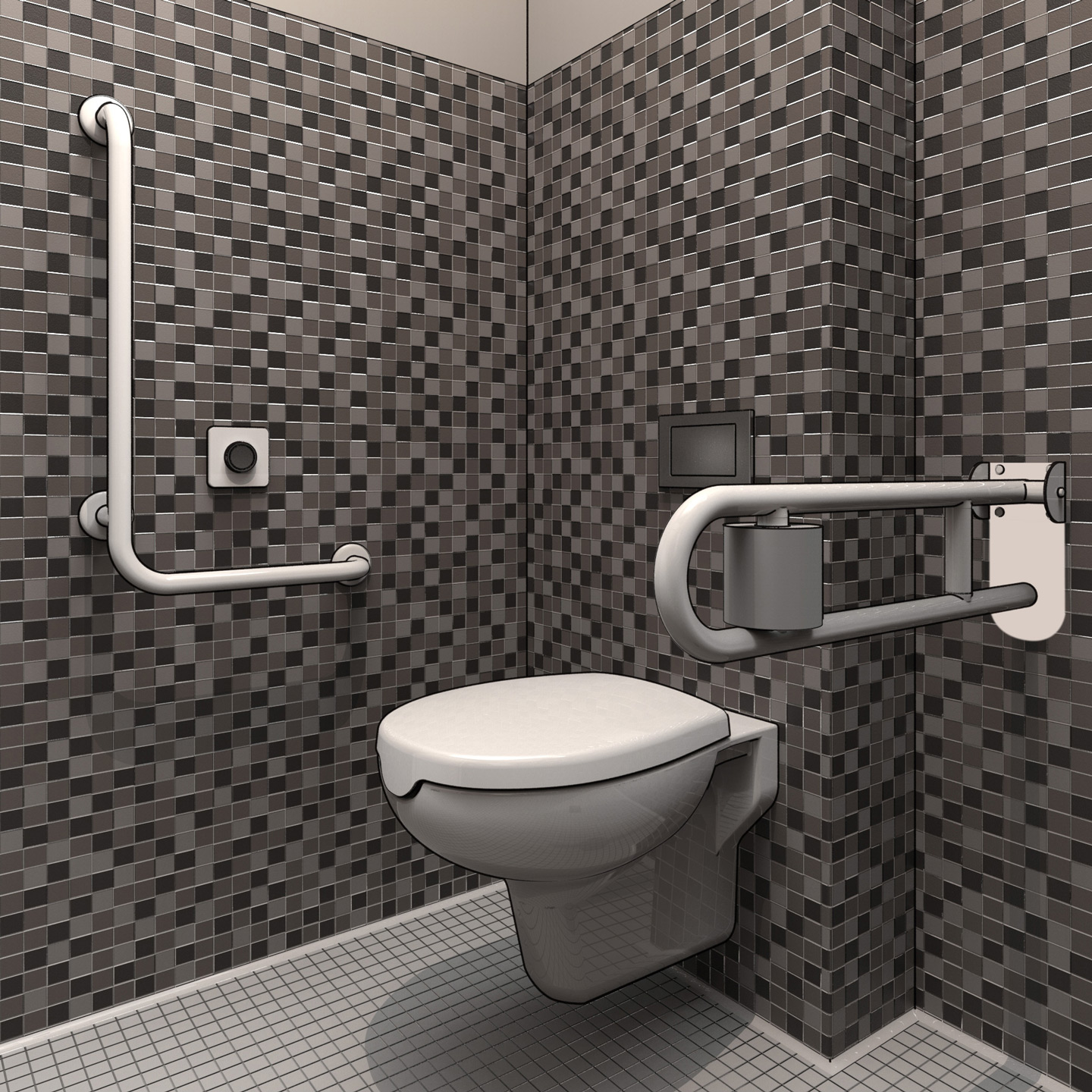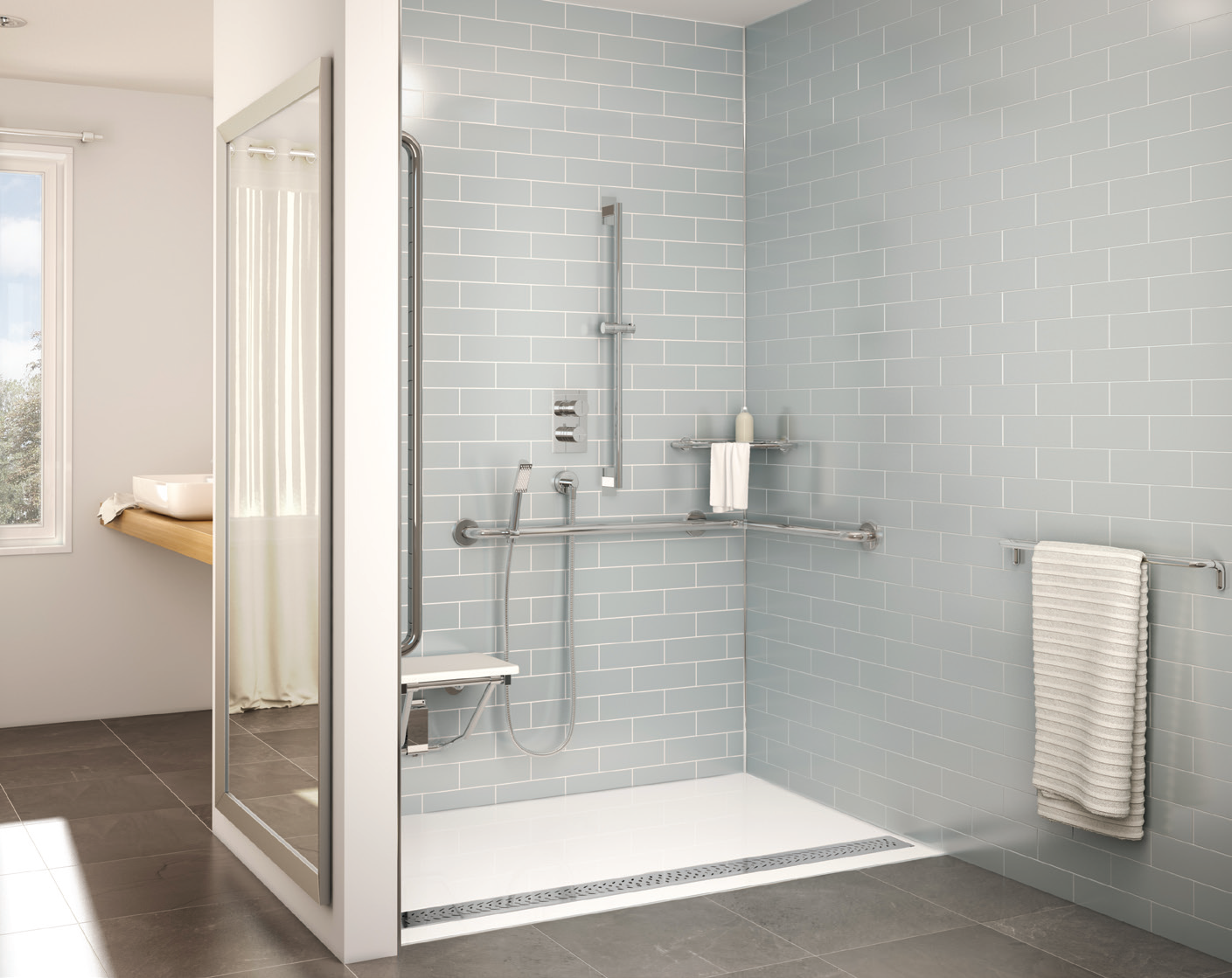Designing Accessible Bathrooms: Small Wheelchair Accessible Bathroom

Creating a wheelchair-accessible bathroom requires careful planning and consideration of specific design elements to ensure safety, comfort, and ease of use for individuals with mobility limitations. This guide will explore the essential features and dimensions required to create a functional and welcoming space.
Minimum Dimensions for Wheelchair Accessibility, Small wheelchair accessible bathroom
A wheelchair-accessible bathroom should provide ample space for maneuverability and transfers. The following dimensions are crucial to ensure a comfortable and safe experience:
- Door Width: A minimum of 32 inches (81 cm) is recommended for a standard door opening. This allows for wheelchair users to easily enter and exit the bathroom.
- Turning Radius: A minimum of 60 inches (152 cm) is required for a 360-degree turn within the bathroom. This space is essential for maneuvering the wheelchair and performing transfers.
- Toilet Clearance: A minimum of 30 inches (76 cm) of clear space is required in front of the toilet. This allows for easy transfer from the wheelchair to the toilet.
- Sink Height: A sink height of 34 inches (86 cm) is ideal for wheelchair users. This ensures comfortable access for washing hands and performing other tasks.
Layout Considerations for Wheelchair Accessibility
A well-designed layout maximizes usability and minimizes potential hazards. Consider the following:
- Clear Pathways: Ensure that all pathways within the bathroom are free of obstacles, including furniture, appliances, and storage units. This allows for easy wheelchair navigation.
- Grab Bars: Strategically placed grab bars near the toilet, shower, and sink provide support for individuals who need assistance with balance and stability. These bars should be installed securely and at a height that is accessible for wheelchair users.
- Toilet Location: The toilet should be positioned in a way that allows for easy access from the wheelchair and adequate space for transfers. Consider using a wall-mounted toilet to maximize floor space.
- Shower/Tub Design: For a safe and comfortable showering experience, consider a walk-in shower with a non-slip floor surface. Alternatively, a bathtub with grab bars and a transfer bench can provide an accessible bathing option.
Tips for Creating a Visually Appealing and Functional Bathroom
While adhering to accessibility guidelines, it is still possible to create a visually appealing and comfortable bathroom:
- Color Palette: Choose light and bright colors to create a sense of spaciousness and enhance visibility. Consider using contrasting colors for features like grab bars and flooring to improve accessibility for individuals with visual impairments.
- Lighting: Ensure adequate lighting throughout the bathroom, especially around the toilet, sink, and shower areas. Consider using a combination of natural and artificial light to create a well-lit environment.
- Storage: Choose storage solutions that are easily accessible from a wheelchair. Consider open shelving, pull-out drawers, and adjustable cabinets.
- Non-Slip Surfaces: Use non-slip flooring materials in the bathroom to minimize the risk of falls. This is especially important in wet areas like the shower and tub.
Essential Features for Accessibility

Creating a small, accessible bathroom requires careful consideration of essential features that ensure ease of use and independence for individuals with mobility limitations.
Roll-In Showers and Wet Rooms
A roll-in shower or wet room is a crucial element in a small accessible bathroom. It eliminates the need to step over a shower threshold, allowing for easy access and maneuverability.
- Roll-in Showers: These showers have a level entry, often with a curb no higher than 2 inches, making it easy for a wheelchair user to roll in. They typically feature grab bars for support and non-slip flooring for safety.
- Wet Rooms: A wet room is a bathroom with a single, waterproof floor that accommodates both showering and bathing. It allows for more space and flexibility compared to a traditional shower stall, but it requires careful waterproofing and drainage to prevent water damage.
The choice between a roll-in shower and a wet room depends on the available space, budget, and individual needs. Roll-in showers are generally more affordable and easier to install, while wet rooms offer more space and flexibility.
Accessible Toilets
Accessible toilets are designed to accommodate individuals with mobility limitations, providing comfort and ease of use.
- Raised Toilets: These toilets are higher than standard toilets, making it easier for individuals to sit down and stand up. They are commonly used in small bathrooms as they do not require significant modifications to the existing plumbing.
- Commode Chairs: Commode chairs are portable toilets that can be used in small spaces, especially when a permanent toilet installation is not feasible. They offer flexibility and can be easily moved around.
- Bidet Toilets: Bidet toilets combine the functions of a toilet and a bidet, offering increased hygiene and comfort. They are often found in larger bathrooms, but some models are designed for smaller spaces.
The choice of accessible toilet depends on the individual’s needs, preferences, and the available space.
Grab Bars
Grab bars provide essential support and stability, enabling individuals to safely and independently use the bathroom.
- Types of Grab Bars: Grab bars are available in various materials, including stainless steel, brass, and plastic. They come in different shapes, sizes, and finishes to match the bathroom’s design.
- Placement Guidelines: Grab bars should be installed securely to the wall studs for maximum support. They should be placed strategically around the toilet, shower, and bathtub, ensuring they are within easy reach. The ADA (Americans with Disabilities Act) provides specific guidelines for grab bar placement and dimensions.
- Safety and Independence: Grab bars significantly enhance safety and independence by providing stability and support for individuals with mobility limitations. They allow for easier transfers, reduce the risk of falls, and promote a sense of security in the bathroom.
Considerations for Small Spaces

Creating a functional and comfortable wheelchair-accessible bathroom in a limited space requires careful planning and creative solutions. Maximizing storage, using visual tricks to enhance spaciousness, and selecting the right color palettes and lighting are key to achieving a welcoming and accessible atmosphere.
Storage Solutions for Small Spaces
Smart storage solutions are crucial for maximizing space in a small bathroom. Wall-mounted shelves, under-sink cabinets, and corner units offer practical ways to keep items organized and within reach.
- Wall-mounted shelves: These shelves can be installed at various heights to accommodate different needs and provide easy access for individuals using wheelchairs. They are ideal for storing toiletries, towels, and other frequently used items.
- Under-sink cabinets: These cabinets offer valuable storage space for cleaning supplies, towels, and other items. Choose cabinets with adjustable shelves for flexibility and ensure sufficient clearance for wheelchair users.
- Corner units: Corner units are a great way to utilize often-wasted space. Look for units with shelves and drawers for maximizing storage potential. Ensure that the unit’s design allows for easy access and maneuvering.
Using Mirrors to Enlargen a Small Bathroom
Mirrors play a significant role in creating a sense of spaciousness in a small bathroom. Strategically placed mirrors can visually enlarge the room and make it feel more open and inviting.
- Large mirrors: A large mirror placed above the sink can reflect light and create the illusion of more space. Choose a mirror with a frame that complements the bathroom’s overall design.
- Multiple mirrors: Placing multiple mirrors on different walls can create a sense of depth and add visual interest to the space. Consider using mirrors with different shapes and sizes for a more dynamic effect.
Color Palettes and Lighting Schemes
The right color palette and lighting scheme can significantly impact the feel and accessibility of a small bathroom. Light colors and well-placed lighting can create a sense of openness and enhance visibility.
- Light colors: Using light colors like white, cream, or pastel shades on walls and fixtures can make the bathroom feel larger and brighter. Avoid using dark colors, as they can make the space feel smaller and cramped.
- Good lighting: Adequate lighting is essential for accessibility and safety. Install sufficient overhead lighting and consider adding task lighting around the sink and mirror for improved visibility. Use energy-efficient LED bulbs for both functionality and cost savings.
